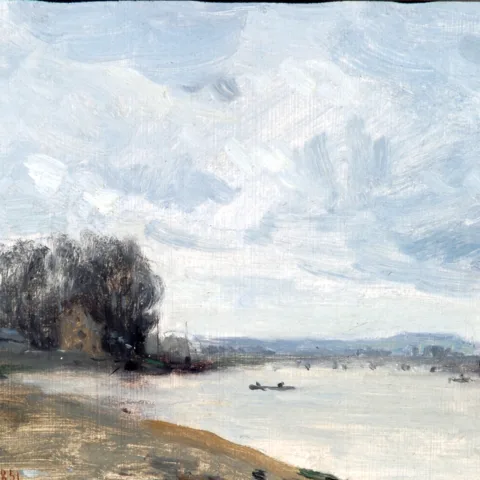The Bowes Museum Blog

St Luke Beats The Transfer Deadline
The oil painting ‘St Luke Drawing the Virgin and Child’, studio of Dieric Bouts was acquired by The Bowes Museum last autumn and is a tremendous addition to the collection, it is a rare example of a painting from Bouts workshop in this country.
On of its many fascinating physical characteristics is that the paint layers have been taken off a wooden panel support and transferred to a linen canvas – or transferred. To understand why that may have been and what it entailed we must go back to the early 1700’s Italy for that is when it was first recorded in any great way. The use of the transfer went on to France and Russia especially and there are great records from the Louvre and the Hermitage that show which paintings transferred and by who.
So to take a paint film from one support and put it on another seems a massive task with lots of risk, why do it? Typically paintings on panels were transferred as panels are subject to warping, cracks, being eaten woodworm, shrinkage and flaking. It has been suggested there was not the knowledge to lay down the flaking or treat damaged boards in the 18th and 19th centuries but I would suggest that it enhanced a restorers standing if he could transfer a painting and owners could see a nice flat picture (at first anyway). To be fair there was a belief that canvas was a better support, with less problems, than panels.
As we get into the 19th century transfers had become rather routine. In one year in the Louvre there is a list showing 84 paintings to be transferred. It also appeared to be fashionable for the owners of paintings to have their paintings transferred. The Bowes painting was transferred in 1899, which is quite late in the day for transfers as they generally faded out in the 1930’s.
The actual paint layers seem in excellent condition for a work of its age. Luckily the restorer kept the original ground/gesso layer and this has preserved the under drawing. In more dramatic transfers the actual gesso layer was also removed – sometimes with weak acids destroying any under drawing. New oil grounds were seen as more flexible and therefore better to put the paint layer on.
There is also no obvious evidence of flaking or woodworm damage on the Bowes’ painting. If it had warped badly we might expect to see lots of vertical cracking but this is also not apparent, with few vertical splits or cracks.
Now we can see a number of drawbacks to transfers, apart from the obvious risks of destroying the paintings themselves or seriously damaging them of course. By putting a painting that had been on panel on a canvas you are fundamentally changing it physically. Paintings will develop different patterns of age cracks depending on whether they are on panels or canvas – so a transfer may end up with both.
The use of transfers died out in the 1930’s but is still occasionally used in exceptional circumstances. Today we value the whole of the painting rather than just the image and surface.
With the Bowes’ painting we can see it looks quite straight forward in normal light, as below:

Full front Normal Light
But in raking light, (light from the side), we can still see the shape of the original panel with its joins. See below:

Joins in the panel
By Jon Old, Conservation Manager







